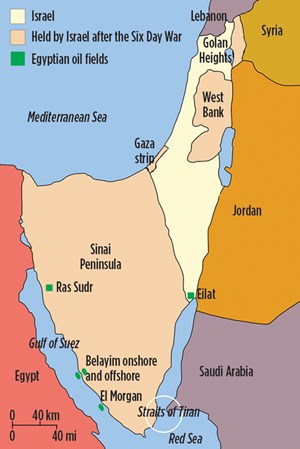Six-Day War: A shipping blockade leads to captured fields
The Six-Day War of June 5-10, 1967—the third major Arab-Israeli conflict in history as of that date—was caused by the continuing Arab rejection of Israel and an Egyptian blockade of Israeli shipping. Specifically, Egypt had expelled UN troops from the Sinai Peninsula and blockaded Israel’s Port of Eilat, which under international law was considered an act of war.
Just before the Six-Day War, the existence of Israel and/or its citizens had hit a critical stage. As the armies of Egypt, Syria and Jordan prepared for battle, the Jewish state already had started thinking in terms of annihilation. Its hospitals prepared for mass casualties from the advanced conventional weapons supplied to the United Arab Republic (a political union between Egypt and Syria, which lasted until Syria seceded after the 1961 Syrian coup d’état, but Egypt kept the name) by the Soviets, and by the West to Jordan. But Israel also feared chemical weapons, which Egypt used during its war with Yemen. Tensions continued to mount, as even more Arab troops massed on the borders, while Israeli Prime Minister Levi Eshkol insisted that diplomatic attempts to resolve the crisis be exhausted, before Israel would consider military action.

On June 5, in reaction to Egyptian forces mobilizing along the Israeli border in the Sinai Peninsula, Israel launched several preemptive airstrikes against Egyptian airfields. This caught Egypt by surprise, and it resulted in nearly complete annihilation of Egypt’s air force, giving Israel air superiority. Simultaneously, the Israelis launched a ground attack into the Gaza Strip, and through portions of the Sinai Peninsula. After some initial resistance, Egyptian leader Gamal Abdel Nasser ordered the Sinai to be evacuated. Meanwhile, Nasser misled Jordan and Syria, by claiming that Egypt had repelled the Israeli air attack. Thus, Jordan and Syria attacked Israel, but the Israelis retaliated against Jordan by launching an offensive to encircle East Jerusalem. Fearing potentially negative international reaction, Israeli forces initially did not move into the Old City. Meanwhile, Israel surprised Syria that day by launching an evening air strike that destroyed two-thirds of the Syrian air force, giving the Israelis air superiority.
On June 6, Israeli Foreign Minister Abba Eban travelled to New York to forestall a UN Security Council ceasefire. A reworked draft resolution was passed later in the day, and Israel and Jordan accepted it, while Egypt, Syria and Iraq rejected it. Given that scenario, Israel attacked further. Israeli forces quickly pursued the Egyptians, pushing them westward while inflicting heavy losses. By June 7, the Israelis had reached the Suez Canal and had captured Sharm el Sheikh in the south of the Sinai. The takeover of the Sinai was completed on June 8, when Israeli forces reached the peninsula’s western coast. In the process, Israeli forces captured the Belayim and Ras Sudr oil fields, which, at the time, accounted for 76.3% of Egypt’s oil output.
Also on June 7, Israel was seizing territory in Jerusalem, and the Jordanians requested that the UN and the Americans persuade Israel to accept a ceasefire. Israel responded with an ultimatum to King Hussein, to select an exact time when the shelling on the western part of the city would cease, and to select a meeting place for both sides to discuss a ceasefire. Israel proceeded toward the Old City to reach Jewish holy sites as quickly as possible. Jordan’s response was evasive, and Israel went ahead with its attack. When King Hussein ordered the Jordanian forces to retreat across the River Jordan, the Israeli forces occupied the rest of the West Bank, unopposed.
On June 8, the Egyptians rejected any ceasefire. When Israel reached the Suez Canal and the decimation of Egypt’s army could no longer be covered up, Nasser then agreed to accept a ceasefire.
Syrians were occupying the strategic Golan Heights, from which they had attacked Israel many times. Therefore, Israel launched an attack on Syria. The Syrians quickly retreated eastward, behind the ceasefire “purple line.” Finally, a ceasefire on the Golan Heights was signed on June 11.
Meanwhile, after the cessation of hostilities, Israel repaired damage done to Belayim field and had the offshore portion back online by October, resulting in output of 50,000 bopd. Restoration of the onshore portion followed, and by November 1967, Belayim field production had reached 90,000 bopd, with expectations of reaching 150,000 bopd during 1968. Fortunately for Egypt, the country had put a new oil field, El Morgan, onstream in April 1967 at 45,000 bopd. After the war, output from the field increased steadily, averaging 160,000 bopd by mid-1968.
Eventually, in November 1975, Israel handed back operation of these Sinai desert oil fields, particularly Ras Sudr, to Egypt in a deal brokered by U.S. Secretary of State Henry Kissinger. The U.S. paid Israel $350 million in compensation for the fields that year, and similar compensation occurred for a number of years after that. ![]()
- Applying ultra-deep LWD resistivity technology successfully in a SAGD operation (May 2019)
- Adoption of wireless intelligent completions advances (May 2019)
- Majors double down as takeaway crunch eases (April 2019)
- What’s new in well logging and formation evaluation (April 2019)
- Qualification of a 20,000-psi subsea BOP: A collaborative approach (February 2019)
- ConocoPhillips’ Greg Leveille sees rapid trajectory of technical advancement continuing (February 2019)


